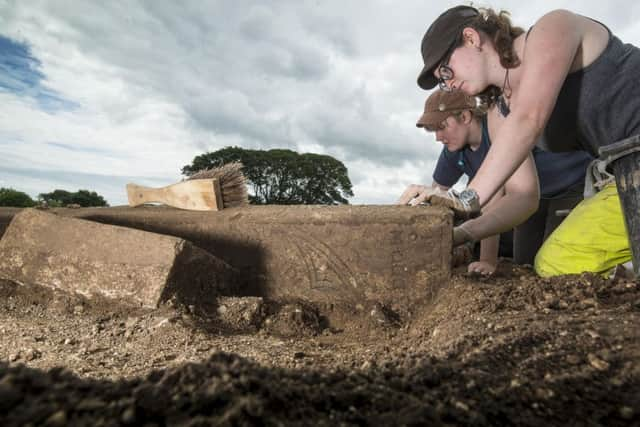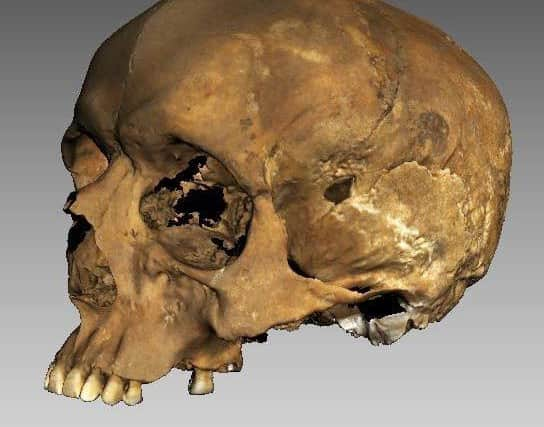'˜Hell on Earth': Yorkshire academics reveal secrets of medieval grave


Academics from the University of Sheffield were responsible for the rare find at Thornton Abbey in Lincolnshire, which was founded as a monastery in 1139 and went on to become one of the richest religious institutions in the world.
The priest’s gravestone was discovered close to the altar of a former hospital chapel.
Advertisement
Hide AdAdvertisement
Hide AdUnusually for the period, it displayed an inscription of the deceased’s name, Richard de W’Peton, and his date of death as 17 April 1317.


The surname is abbreviated from ‘Wispeton’, a medieval incarnation of modern Wispington in Lincolnshire
The slab also contained an extract from the Bible which reads: “That at the name of Jesus every knee should bow, of those in heaven, and of those on earth, and of those under the earth.”
The discovery of Richard’s grave was made by University of Sheffield PhD student Emma Hook, who found his skeletal remains surrounded by the decayed fragments of a wooden coffin.
Advertisement
Hide AdAdvertisement
Hide AdShe said: “After taking Richard’s skeleton back to the laboratory, despite poor preservation, we were able to establish Richard was around 35-45 years old at the time of his death and that he had stood around 5ft 4in tall. Although he ended his days in the priesthood, there is also some suggestion that he might have had humbler origins in more worldly work.


“His bones show the marks of robust muscle attachments, indicating that strenuous physical labour had been a regular part of his life at some stage. His teeth show distinctive lines known as dental enamel hypoplasia, indicating that his early years had been marked by a period of malnutrition or illness.”
To further investigate Richard’s health, researchers in the Department of Archaeology produced a 3D scan of his skull. The model enables detailed features of the skull to be seen with much more ease than with the naked eye.
It reveals a potentially violent episode in the priest’s past.
Advertisement
Hide AdAdvertisement
Hide AdA slight depression in the back of his skull shows evidence of blunt force trauma suffered many years before his death.
Investigations were unable to shed light on the cause of his demise at what would seem to us a relatively young age but there is another possibility that researchers are exploring.
Dr Hugh Willmott from the University of Sheffield’s Department of Archaeology, who has been working on the excavation site at Thornton Abbey since 2011, said: “2017 marks not only the 700th anniversary of Richard’s death, but also that of a catastrophic event that is now largely forgotten, but caused years of suffering for the whole of Europe: the Great Famine of 1315-1317.
“Triggered by a whole spring and summer of relentlessly heavy rain that caused widespread crop failures – which vastly depleted the availability of grain for humans and hay or straw for animals – this was a period of mass starvation.
Advertisement
Hide AdAdvertisement
Hide Ad“Although not on the same scale as the Black Death, which devastated Europe from 1346-1353 and which also left its mark at Thornton Abbey, these hungry times struck rich and poor alike, killing millions across the continent.”
He added: “By spring 1317, when Richard died, the crisis was at its peak and its events would undoubtedly have affected medieval hospitals like Thornton Abbey, and the priests who served there.”
Black Death
This is the latest significant archaeological find at Thornton Abbey in Lincolnshire.
Last year a mass burial of bodies, known to be victims of the Black Death, was discovered at the hospital by experts at Sheffield University.
Advertisement
Hide AdAdvertisement
Hide AdThe site, for centuries lost to the land, contains male and female adults along with the remains of 27 children, and suggests that the 14th century community, overwhelmed by the Black Death, was simply unable to cope with the number of victims.
It was one of the worst pandemics in human history, claiming up to 200 million lives as it swept continental Europe from 1346 to 1353, before reaching Lincolnshire in the spring of 1349.